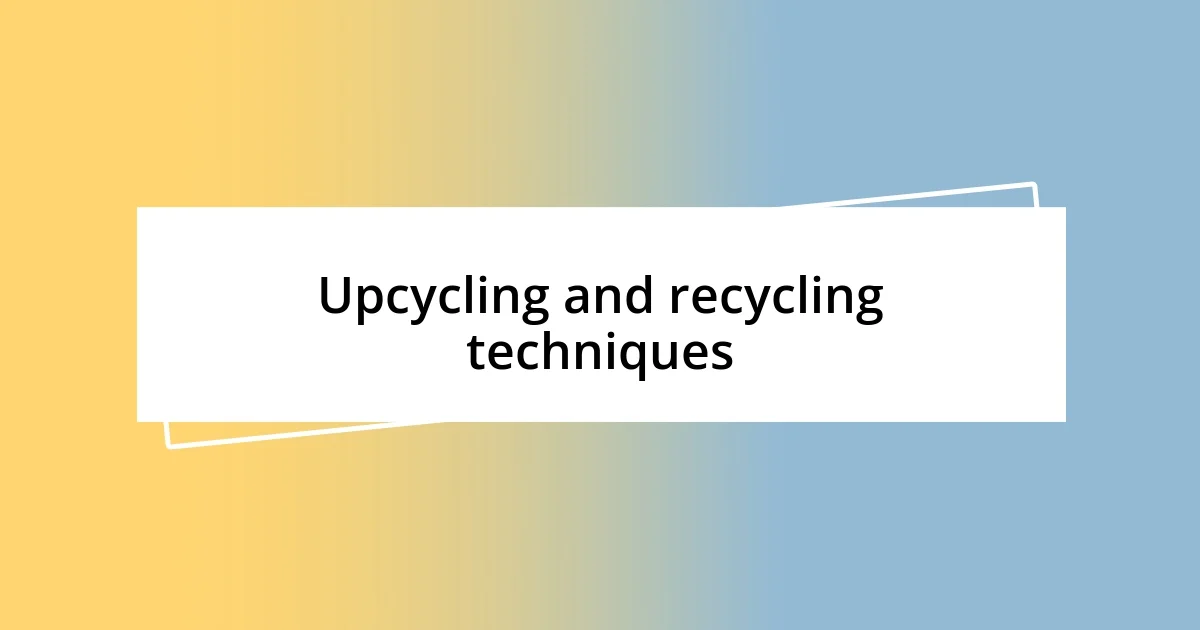Key takeaways:
- Sustainable accessories promote environmental consciousness by using ethical materials and supporting fair labor practices, enhancing both style and social impact.
- Choosing eco-friendly production methods, such as upcycling and natural dyes, fosters creativity while reducing waste and pollution.
- Future trends include personalized sustainable items and the integration of technology, encouraging conscious consumerism and fostering community engagement.

Understanding sustainable accessories
Sustainable accessories are not just a trend; they represent a conscious choice to reduce our environmental impact. I remember when I first stumbled upon a brand that sourced materials from recycled plastics. The feeling of knowing that my purchase contributed to a cleaner ocean was exhilarating—it’s amazing how choices can create ripples in the world.
When I think about sustainability, I often ask myself: what materials are being used in the products I buy? This question drives me to research the story behind the items I choose. The realization that a beautiful bag made from organic cotton supports fair labor practices often brings a smile—it feels good to know I’m making a positive difference, however small.
In my experience, sustainable accessories often come with a rich backstory that deepens our connection to them. Each piece seems to carry a narrative, whether it’s about artisans in a small village or innovative uses of waste materials. How often do we stop and consider not just the fashion statement we’re making, but also the impact it has on communities and the planet? Embracing sustainable accessories has not only transformed my wardrobe but also reshaped my perspective on consumption.

Importance of ethical materials
When I came across the term “ethical materials,” it struck a chord with me. I vividly remember one particular shopping experience where I learned that a gorgeous pair of shoes I loved was made from ethically sourced leather. The realization that my purchase could support sustainable farming practices was both empowering and eye-opening. Ethical materials aren’t just about reducing harm; they’re about actively contributing to a better world.
Here are some reasons why ethical materials matter:
- Environmental Impact: Sourcing materials responsibly reduces pollution and conserves natural resources.
- Fair Labor Practices: Ethical materials often come from suppliers committed to providing safe working conditions and fair wages.
- Quality and Longevity: Products made from ethical materials tend to be of higher quality, promoting long-term use and reducing waste.
- Transparency: Brands that prioritize ethics often share the story behind their materials, fostering trust and connection with consumers.
- Emotional Connection: Knowing the story behind what I wear enhances my experience, creating a sense of pride in my choices.

Choosing eco-friendly production methods
Choosing eco-friendly production methods is essential in my quest for sustainable accessories. I fondly recall visiting a local workshop that specialized in upcycling discarded materials into stunning bags. Seeing the artisans transform what once was waste into wearable art was not just fascinating; it sparked a deep appreciation for innovation in sustainability. The process showcased a beautiful intertwining of creativity and eco-consciousness, making every piece unique.
One production method I’ve come to admire is the use of natural dyes. I remember discovering that certain brands use plant-based dyes that are not only environmentally friendly but also create richer colors. The thought that a vibrant scarf could be made from indigo plants rather than harmful chemicals genuinely reshaped how I view color in fashion. It’s easy to overlook these details, but they transform the ordinary into something extraordinary, all while being kind to the earth.
Another approach I appreciate is local production. I’ve seen firsthand how supporting local artisans reduces carbon footprints, as products travel shorter distances. Many of these makers employ traditional techniques passed down through generations, which not only preserves culture but also results in higher-quality goods. The excitement I feel when purchasing a handmade piece, knowing it supports a local economy and isn’t mass-produced, is truly rewarding.
| Production Method | Benefits |
|---|---|
| Upcycling | Reduces waste, promotes creativity, creates unique products. |
| Natural Dyes | Enviro-friendly, vibrant colors, less chemical pollution. |
| Local Production | Supports local economies, reduced carbon footprint, preserves traditional techniques. |

Upcycling and recycling techniques
Upcycling holds a special place in my heart because it breathes new life into materials that might otherwise end up in a landfill. I remember visiting a community workshop where artisans would take old denim and transform it into trendy tote bags. The moment I held one, I was struck not only by its unique color and texture but also by the story behind it. Isn’t it incredible how something discarded can become a fashionable accessory with a purpose?
Recycling techniques, on the other hand, can be deeply fascinating. I once came across a brand that specializes in creating jewelry from reclaimed metal and glass. The thought of beautifully reimagined materials ignited a spark in me; there’s something truly magical about how those pieces blend history and art. It made me wonder, what other treasures can we uncover by looking at waste through a different lens? It’s a gentle reminder that creativity can flourish in the most unexpected places.
The emotional connection to upcycled accessories often enhances my appreciation for them. Each piece carries its own narrative, reminding me that sustainability can be both stylish and meaningful. I cherish the moment I wear an upcycled necklace; it feels like I’m part of a broader movement, one where choosing sustainable fashion is a statement of individuality and consciousness. How often do we stop to consider the journeys these items have taken before they become a part of our lives?

Supporting sustainable brands
Supporting sustainable brands isn’t just a trend; it’s a commitment I embrace wholeheartedly. I still remember the thrill of discovering a local eco-conscious brand that collaborates with artisans in developing countries. Each purchase not only comes with a story but also supports fair wages and community development. Isn’t it uplifting to know that our spending choices can directly uplift lives?
What truly resonates with me is the transparency these brands offer. During a visit to a pop-up market, I chatted with a brand owner who shared the entire lifecycle of their products, from sourcing to production. It felt invigorating to connect with a person whose values aligned so closely with my own and who genuinely cared about making a positive impact. This level of honesty transforms shopping into a dialogue rather than a transaction, don’t you think?
I also find myself more inclined to support brands that prioritize sustainability in every aspect of their business. Once, I stumbled upon a jewelry line that not only used recycled materials but also invested in reforestation projects. The thought of wearing a piece that not only looks good but also contributes to healing the planet made my purchase feel much more significant. When brands incorporate purpose into their mission, it puts a real meaning behind every accessory we adorn ourselves with. What better way to express style than with a story that benefits our world?

Care and maintenance for longevity
Taking care of my sustainable accessories is a bit like nurturing a friendship; it requires time and attention. I’ve found that simply storing my items properly can make a huge difference in their longevity. For instance, I always keep my jewelry in a soft pouch to prevent scratches and tangles. Isn’t it funny how sometimes we overlook these little details, only to later wonder why our favorite piece isn’t looking its best?
Cleaning is another crucial aspect of maintenance. I’ve learned that using gentle, eco-friendly cleaners preserves both the look and integrity of my accessories. One time, I neglected to clean my leather bag, and it began to show signs of wear much sooner than I expected. That experience taught me the value of routine care. How often do we consider the impact of our cleaning choices not just on our items but also on the environment?
Lastly, I believe that investing in repairs instead of replacements reflects true sustainability. I once had a bracelet that broke at an inopportune moment. Rather than tossing it aside, I chose to have it repaired by a local artisan. When I got it back, it felt like new, and I appreciated the craftsmanship even more. Isn’t it rewarding to see how a little care can keep our beloved items with us longer, while also supporting skilled hands in our community?

Future trends in sustainable accessories
As I look ahead, I see a rising trend in personalized sustainable accessories. Recently, I stumbled upon a concept where customers can design their own pieces using eco-friendly materials. This isn’t just about craftsmanship; it’s about making a statement that reflects our individual values and styles. Don’t you think it’s powerful to wear something that tells a personal story while also being kind to the planet?
Another exciting development is the integration of technology in sustainable accessories. For example, I came across smart wearables that track environmental impacts of my daily choices. These innovations not only enhance our style but also create awareness of how our consumption affects the world. When I first used one of these devices, it opened my eyes to my carbon footprint in a way I never anticipated. Is it too much to hope that this knowledge could inspire more conscious choices?
I’m also noticing a shift towards circular fashion practices, where customers are encouraged to return used items for recycling or upcycling. I once participated in a swap event that focused on exchanging gently used accessories, and it felt like a mini community celebration! This kind of engagement not only extends the lifespan of products but also cultivates a sense of belonging among like-minded individuals. Isn’t it amazing how sustainable living can foster connections while reducing waste?














